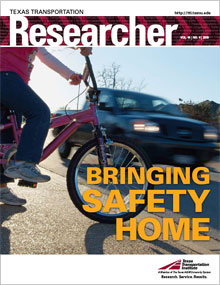Enhancing Visibility to Improve Safety on Houston’s “Red Line”

Visitors to downtown Houston, Texas, have probably seen Houston METRO’s “Red Line.” It’s a 7.5-mile stretch of light rail transit (LRT) that links the Central Business District with Midtown, the Museum District, the Texas Medical Center and Reliant Park. What visitors might not have noticed is how some motorists seem to ignore vehicle-train safety.
A number of crashes have occurred on the Red Line involving passenger and light-rail vehicles, with one crash resulting in a fatality. Since driver distraction and inattention seem to be contributing factors to the crashes, Houston METRO and the Texas Transportation Institute (TTI) are evaluating technologies that could make those crossings safer.
“This is a three-year evaluation designed to test technologies that supplement standard traffic control devices at the LRT crossing. The goal is to reduce the kinds of driver behavior that may lead to crashes,” says Tony Voigt, program manager for TTI’s Houston Office for Research and Implementation. “If we can help drivers pay better attention to what the signals, signs and pavement markings are already telling them, we can help keep drivers, pedestrians and transit riders safer.”
Houston METRO asked TTI to assist them in evaluating technologies that help prevent motorists from creeping into the LRT grade crossing, running red lights or making a right turn on red onto Main Street, a prohibited maneuver. The Federal Highway Administration (FHWA) requires properly assessing the effectiveness of these technologies as part of its experimental approval process.
“We looked at red-light running because it can correlate to the potential for crashes at those intersections,” explains Associate Transportation Researcher Jonathan Tydlacka, TTI’s key technical expert on the project. “If we can identify technologies to help reduce red-light running, in theory the number of crashes would likely come down as well.”
Specifically regarding the encroachment issue, TTI evaluated the effectiveness of an illuminated stop bar, which is a line of red light-emitting diode (LED) lights placed in the pavement in front of the traditional white painted stop bar. The red pavement lights turn on when the traffic signal indication is solid red but are off at all other times. As an additional countermeasure, researchers evaluated the use of a red LED outline on the backplate around the traffic signal head to see whether or not drivers paid more attention to the signal with the outlined backplate in place. The red outline on the backplate is illuminated only when the traffic signal indication is red.
The research team found that the illuminated stop bars reduced right turn on red violations. The LED backplates tended to reduce red-light running a noticeable amount and reduced some of the right-turn-on-red violations as well. Researchers will conduct another year of evaluation at the original test locations before completing a final report, which will include analysis of crash data at the intersections for two years before and three years after the test devices were installed. The safety performance during night versus day will also be studied in further analysis. The five years of data provides an adequate context for evaluating the potential efficacy of the devices.
“Currently we have TTI evaluating the real-world effectiveness of these technologies, and based on their findings, it has been very effective to date,” says Walter Langford, Houston METRO’s senior project manager of traffic signal programs. “Once all the data is analyzed, we will use the information to proceed to the next step in the process of incorporating these items into the Texas Manual on Uniform Traffic Control Devices as a standardized safety device.”
